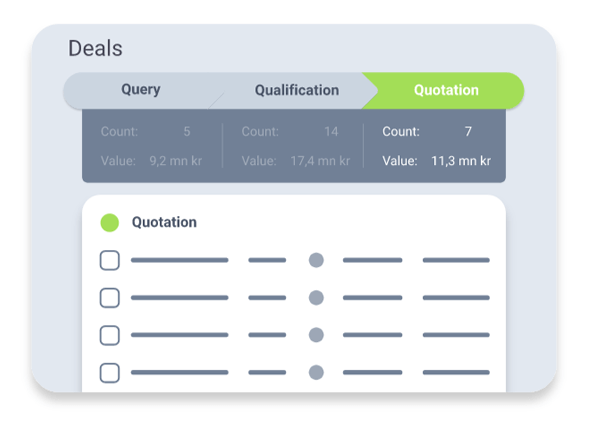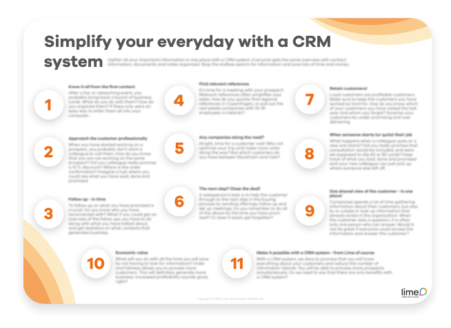Pipeline management is the key to reach your sales goals

Moving your prospects through every step of your sales process is not always easy. With a defined strategy for pipeline management, you will increase your close ratio, and better understand which prospects that are ready for the next step.
What is pipeline management?
In sales, pipeline management can be defined as a process of managing sales opportunities. The trick is to push the lead from one step to the next in your sales process. Every lead has to go through each step before the deal can be closed.
Pipeline management in CRM gives you a visual context to every part of the sales funnel. While certain actions apply to all incoming leads, the sales pipeline should not be seen as a rule, but rather a guideline to keep your list of prospects up to date.
Building a sales pipeline that will help you surpass your sales goals
Depending on your business, whether you work with B2B clients or consumer services, your sales pipeline will have a certain number of steps. These are the steps that each potential customer has to pass before you are ready to close the deal.
Let’s take a look at one example of a B2B sales process:
- Prospecting new potential customers in your CRM
Contacting the right people at the right time is essential when working in sales. With a clear vision of whom to contact, you avoid spending time on talking to people that will not be interested in your solutions. - First call to schedule a meeting
The initial contact is vital, and you only get one chance to make a good first impression. Make sure you understand the customer’s needs and challenges before making your first move. Or, if you need to take a chance, make sure that the first call is one where you listen to your customer. Avoid pushing your product when the customer clearly is not at the right stage. - Let’s have a chat – or two
When you have established a contact – and hopefully scheduled your first meeting – your sales process will decide your next step. In B2B sales, the sales cycle often takes several months before the deal is closed. This is when a well defined strategy will help you to make the right move at the right time. - Presenting your offer
Your lead is ready for the move, and it is time to present your offer. Make sure to leave room for negotiation. From previous conversations, you have already defined the pain points of your prospects. These are the obstacles that your offer will present a solution for. - Close the deal
When you have reached an agreement, it is time to close the deal. - Never forget to follow up
The deal is done, but not your work. If you want to continuously improve your pipeline management, you also need to know the customer lifetime value. This is defined by how long a customer chooses to continue using your products or services. By identifying which leads that leads to long-lasting, paying customers, you will be able to estimate the value of your current – and future – sales pipeline.
This example obviously leaves room for a lot of details. What you need to consider is to always work systematically with your sales pipeline to find strengths and weaknesses in your strategy.
What is a sales pipeline strategy?
By designing a visual sales cycle in your CRM system, you will have a clear view of how many leads that are active in each step of the sales process. This is an act of balance, where successful sales reps will manage to add new prospects at the same pace that new deals are closed.
Your pipeline strategy starts with defining a structured sales process. You will not be able to lead the way if you do not know where you need to go. It is like navigating without a map nor a compass; you might get there in the end, but not with the speed you need.
Working with pipeline management enables you to always have a plan of action. What will happen after the initial meeting? When is your prospect ready to be presented with a solution? These are the questions you will be able to answer after defining your sales pipeline.

Why is pipeline management in CRM important?
While prospecting is a vital start in any sales process, knowing your next step is equally important. If you want to gain a better understanding in when a lead is ready for a sales meeting or closing a deal, you should start by defining a strategy for managing your pipeline.
Mastering the art of pipeline management will maximise your sales opportunities, by predicting future revenue. When consistently using the same process, it will become easier to spot strengths and weaknesses in your sales process.
By working with pipeline management you can identify the lifetime of a lead, providing a clear vision of how many prospects you need to have in your sales pipeline to be able to reach your revenue goals.
Keep track on your pipeline metrics in CRM
What is a “good” lead? By identifying valuable data about your prospects, you will know what metrics to manage in your sales pipeline. These metrics could be, but are not limited to:
- Number of leads/prospects in your sales funnel.
- Close ratio: How many leads converts into an actual deal?
- Average size of deals: The monetary value of an average deal.
- Lead lifetime: How long does it take from initial contact to a closed deal?
By reviewing each metric, you will gain a better understanding when your leads are ready to move to the next step in your pipeline. It will also enable you to avoid having empty slots in parts of your sales funnel.
A steady flow of incoming leads, on-going sales calls, and sent quotations characterise a successful sales rep. Achieving this balance pave the way for an even workload over time, and help you to reach your sales goals in the long run.
Conclusion: Pipeline management in CRM is a recipe for success over time
Creating a structure for your sales pipeline is not the same as doing “what always has been done”. Neither should it lower your motivation by setting up “rules” that need to be followed.
Instead, look at it as a recipe for success over time. Make small adjustments, and evaluate the results to gain knowledge of what makes or breaks a deal. By always leaving room for small improvement, pipeline management in CRM is a recipe for success over time.
Simplify your everyday workload with smart functions in CRM

Are you missing out on sales opportunities?
Take a look at the benefits of a CRM, and how it can help you reach your sales goals every month.
Want better pipeline mangement?
There’s no time to waste! Let’s find the solution that will help you get more customers and turn existing ones into loyal ambassadors today.